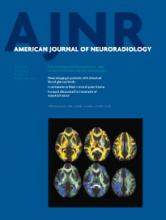Article Figures & Data
Tables
Variablea Patients (n = 408) Age (yr) 33.3 ± 14.1 Men 230 (56) Presenting symptoms Hemorrhage 196 (48) Seizure 115 (28) Spetzler-Martin grade I 41 (10) II 124 (30) III 143 (35) IV 81 (20) V 19 (5) AVM location Cortical 312 (76) Deep 66 (16) Infratentorial 30 (7) Eloquent 231 (59) AVM characteristics Deep drainage 159 (39) Intranidal aneurysm 55 (14) Number of procedure 1 Session 157 (38) 2 Sessions 118 (29) 3 Sessions 75 (18) ≥ 3 Sessions 58 (14) ↵a No. (%); mean ± SD.
Variablea Overall (n = 92) AP (n = 44) NAP (n = 48) P Value AVM location Cortical 77 (84) 41 (93) 36 (75) <.041 Deep 11 (12) 3 (7) 8 (17) Infratentorial 4 (4) 0 (0) 4 (8) Eloquent 53 (58) 17 (39) 36 (75) <.001 Type of HC Intraparenchymal hemorrhage 46 (50) 12 (27) 34 (71) <.001 Subarachnoid hemorrhage 35 (38) 31 (71) 4 (8) Intraventricular hemorrhage 11 (12) 1 (1) 10 (21) Timing of rupture Hemorrhage during procedure 52 (59) 43 (98) 9 (18) <.001 Delay between procedure and hemorrhagic events, hours (range) 17.2 (0–240) 0.05 (0–2) 34.4 (0–240) <.001 Craniotomy for hematoma evacuation, decompressive craniotomy or EVD 15 (16) 3 (7) 12 (25) <.019 Note:—EVD indicates external ventricular drainage.
↵a No. (%), mean ± SD or range.
Variablea Overall (n = 827) Without HC (n = 735) With HC (n = 92) P Value (without vs with HC)b Type of Hemorrhagic Complications AP (n = 44) NAP (n = 48) P Value (AP vs NAP)b New disability 127 (15) 78 (11) 49 (53) <.001 12 (27) 37 (77) <.001 Transient 71 (9) 53 (7) 18 (20) 9 (20) 9 (19) Permanent 56 (7) 25 (3) 31 (34) 3 (7) 28 (58) Death 6 (1) 0 (0) 6 (7) <.001 1 (2) 5 (10) <.207 Variablea No Hemorrhagic Complications (n = 735) NAP (n = 48) P Value Age (yr) 32.2 ± 13.7 33.9 ± 14.4 .405 Hemorrhagic presentation 316 (43) 18 (38) .419 Nidus diameter (cm) 4.1 ± 3.8 3.9 ± 3.5 .553 Spetzler-Martin gradeb III III .874 AVM involving eloquent area 443 (60) 36 (75) .164 Deep venous drainage 317 (43) 21 (44) .660 Intranidal aneurysm presence 107 (15) 6 (13) .513 Venous stenosis 40 (5) 5 (10) .227 Venous ectasia 372 (51) 25 (3) .596 Premature venous occlusion 3 (0.4) 8 (17) <.001 Complete occlusion of AVM 181 (25) 18 (38) .114 Detachable microcatheter 127 (17) 7 (15) .606 Onyx volume (mL) 2.1 ± 2.0 2.9 ± 1.9 <.02 Total embolic agent volume (mL)c 2.5 ± 1.9 3.2 ± 1.6 <.03 Ratio of Onyx volume (mL)/nidus diameter (cm) 0.6 ± 0.6 0.8 ± 0.6 <.01 Ratio of Vea (mL)/nidus diameter (cm)c 0.7 ± 0.6 0.9 ± 0.6 <.01 No. of pedicles embolized in each procedureb 1 1 .629 - Table 5:
Independent predictors of hemorrhagic events in AVM size subdivisions of the no arterial perforation group
Variable β Odds Ratio 95% Confidential Interval P Valuea Small AVMb Premature venous occlusion 3.8 44.3 4.24–462.04 <.001c Total embolic agent volume 0.3 1.4 1.07–1.85 <.013c Constantd −3.6 0.03 <.001 Mid-size AVMb Premature venous occlusion 3.1 23.4 3.7–148.4 <.002c Constantd −2.7 0.06 <.001 Large AVMb Premature venous occlusion 24.2 3.2−10 .00 1.00e Constantd −3.0 0.05 <.001












